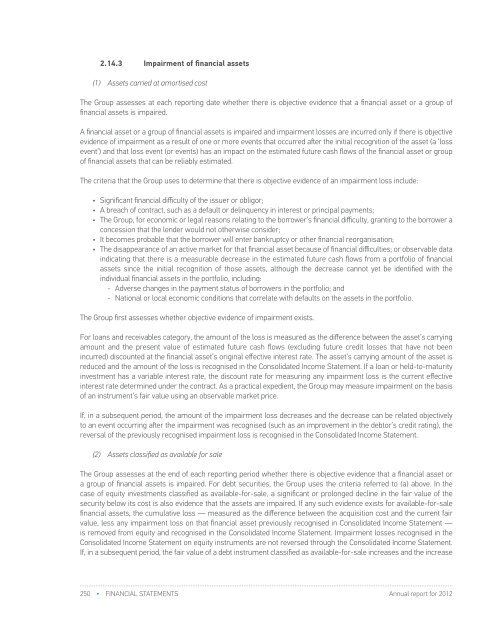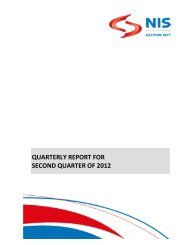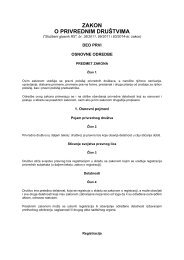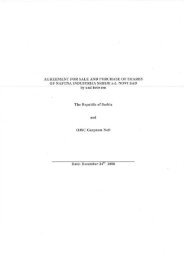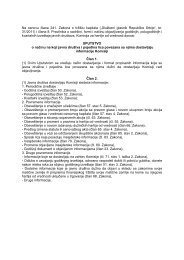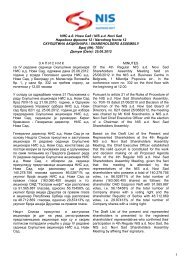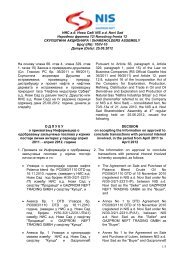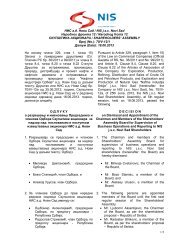FY 2012 - Investor Relations - NIS
FY 2012 - Investor Relations - NIS
FY 2012 - Investor Relations - NIS
Create successful ePaper yourself
Turn your PDF publications into a flip-book with our unique Google optimized e-Paper software.
2.14.3 Impairment of financial assets(1) Assets carried at amortised costThe Group assesses at each reporting date whether there is objective evidence that a financial asset or a group offinancial assets is impaired.A financial asset or a group of financial assets is impaired and impairment losses are incurred only if there is objectiveevidence of impairment as a result of one or more events that occurred after the initial recognition of the asset (a ‘lossevent’) and that loss event (or events) has an impact on the estimated future cash flows of the financial asset or groupof financial assets that can be reliably estimated.The criteria that the Group uses to determine that there is objective evidence of an impairment loss include:• Significant financial difficulty of the issuer or obligor;• A breach of contract, such as a default or delinquency in interest or principal payments;• The Group, for economic or legal reasons relating to the borrower’s financial difficulty, granting to the borrower aconcession that the lender would not otherwise consider;• It becomes probable that the borrower will enter bankruptcy or other financial reorganisation;• The disappearance of an active market for that financial asset because of financial difficulties; or observable dataindicating that there is a measurable decrease in the estimated future cash flows from a portfolio of financialassets since the initial recognition of those assets, although the decrease cannot yet be identified with theindividual financial assets in the portfolio, including:--Adverse changes in the payment status of borrowers in the portfolio; and--National or local economic conditions that correlate with defaults on the assets in the portfolio.The Group first assesses whether objective evidence of impairment exists.For loans and receivables category, the amount of the loss is measured as the difference between the asset’s carryingamount and the present value of estimated future cash flows (excluding future credit losses that have not beenincurred) discounted at the financial asset’s original effective interest rate. The asset’s carrying amount of the asset isreduced and the amount of the loss is recognised in the Consolidated Income Statement. If a loan or held-to-maturityinvestment has a variable interest rate, the discount rate for measuring any impairment loss is the current effectiveinterest rate determined under the contract. As a practical expedient, the Group may measure impairment on the basisof an instrument’s fair value using an observable market price.If, in a subsequent period, the amount of the impairment loss decreases and the decrease can be related objectivelyto an event occurring after the impairment was recognised (such as an improvement in the debtor’s credit rating), thereversal of the previously recognised impairment loss is recognised in the Consolidated Income Statement.(2) Assets classified as available for saleThe Group assesses at the end of each reporting period whether there is objective evidence that a financial asset ora group of financial assets is impaired. For debt securities, the Group uses the criteria referred to (a) above. In thecase of equity investments classified as available-for-sale, a significant or prolonged decline in the fair value of thesecurity below its cost is also evidence that the assets are impaired. If any such evidence exists for available-for-salefinancial assets, the cumulative loss — measured as the difference between the acquisition cost and the current fairvalue, less any impairment loss on that financial asset previously recognised in Consolidated Income Statement —is removed from equity and recognised in the Consolidated Income Statement. Impairment losses recognised in theConsolidated Income Statement on equity instruments are not reversed through the Consolidated Income Statement.If, in a subsequent period, the fair value of a debt instrument classified as available-for-sale increases and the increasecan be objectively related to an event occurring after the impairment loss was recognised in Consolidated IncomeStatement, the impairment loss is reversed through the Consolidated Income Statement.2.15. InventoriesInventories are stated at the lower of cost and net realisable value. Cost is determined using the weighted averagemethod. The cost of finished goods and work in progress comprises cost of raw materials, direct labour, other directcosts and related production overheads (based on normal operating capacity). It excludes borrowing costs.Net realizable value is the estimated selling price in the ordinary course of business, less applicable variable sellingexpenses.Spare parts for equipment used in production are stated at cost The impairment test of inventories i.e. spare parts dueto damage or obsolescence is performed once a year. Impairment losses are recognized as other expenses (note 34).2.16. Non-current assets (or disposal groups) held-for-saleNon-current assets (or disposal groups) are classified as assets held for sale when their carrying amount is to berecovered principally through a sale transaction and a sale is considered highly probable. They are stated at the lowerof carrying amount and fair value less costs to sell if their carrying amount is to be recovered principally through a saletransaction rather than through a continuing use. Assets are reclassified when all of the following conditions are met:(a) the assets are available for immediate sale in their present condition; (b) the Group’s management approved andinitiated an active programme to locate a buyer; (c) the assets are actively marketed for sale; (d) the sale is expectedwithin one year; and (e) it is unlikely that significant changes to the sales plan will be made or that the plan will bewithdrawn.2.17. Trade receivablesTrade receivables are amounts due from customers for products and merchandise sold or services performed in theordinary course of business. If collection is expected in one year or less (or in the normal operating cycle of the businessif longer), they are classified as current assets. If not, they are presented as non-current assets. Alternatively, tradereceivables are stated as long-term.Trade receivables are recognized initially at fair value and subsequently measured at amortized cost using the effectiveinterest method, less provision for impairment. A provision for impairment of trade receivables is established whenthere is objective evidence that the Group will not be able to collect all amounts due according to the original terms ofreceivables. Significant financial difficulties of the debtor, probability that the debtor will enter bankruptcy or financialreorganization, and default or delinquency in payments (more than 90 days for state controlled companies and morethan 60 days overdue for other customers) are considered indicators that the trade receivable is impaired. The amountof the provision is the difference between the asset’s carrying amount and the present value of estimated future cashflows, discounted at the original effective interest rate. The carrying amount of the asset is reduced through the use ofan allowance account, and the amount of the loss is recognised in the Consolidated Income Statement within ‘otherexpenses’ (note 34). When a trade receivable is uncollectible, it is written off against the allowance account for tradereceivables. Subsequent recoveries of amount previously written off are credited to ‘other income’ in the ConsolidatedIncome Statement (note 33).2.18. Cash and cash equivalentsCash and cash equivalents includes cash in hand, cash in banks, deposits held at call with banks, other short-termhighly liquid investments with original maturities of three months or less, and bank overdrafts. Bank overdrafts areshown within borrowings in current liabilities on the Consolidated Balance Sheet.250 • FINANCIAL STATEMENTS Annual report for <strong>2012</strong>Annual report for <strong>2012</strong>FINANCIAL STATEMENTS • 251


